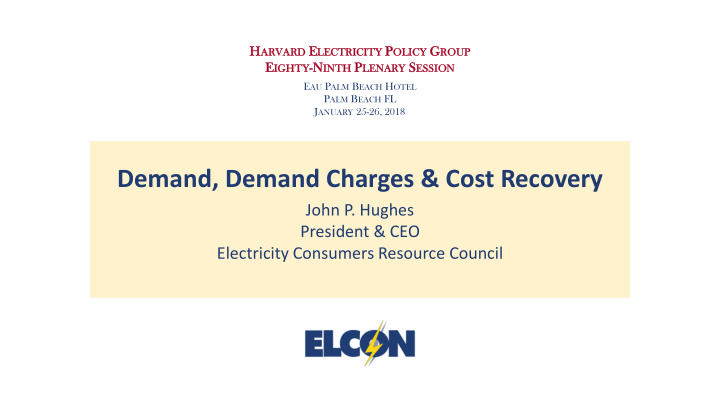



H ARVARD E LECTRICITY P OLICY G ROUP UP E IGH IGHTY -N INTH P LENA RY S ESSI NARY SSION E AU P ALM B EACH H OTEL P ALM B EACH FL J ANUARY 25-26, 2018 Demand, Demand Charges & Cost Recovery John P. Hughes President & CEO Electricity Consumers Resource Council
Why Am I Here. • ELCON was founded in 1976 in anticipation of the enactment of PURPA. • A plenary concern at the time was the growing state regulatory policy to shift fixed costs into energy charges, which resulted in cross-class subsidization. • The initial motive was to isolate residential ratepayers from high fuel costs imposed by the OPEC Oil Embargo. • ELCON is very protective of two- and three- part tariff structures.
Cross-Class Subsidization • Expanding volumetric energy charges became a preferred tool to promote (and fund) various social policies: – Lifeline Rates – DSM – Opposition to Declining Block Rates • By the mid-1980s, industrial ratepayers were subsidizing residential ratepayers by $2.5 billion per year ($5.7 billion in 2017 dollars). The ROR provided by industrials exceeded that of residentials in 79 of 84 utility cost-of-service studies. 1 • Recent attempts to expand the subsidies are to promote net metering and roof-top photovoltaics. 1 Electricity Consumers Resource Council, Profiles in Electricity Issues: Cost-of-Service Survey, March 1986
Instantaneous Customer Demands Drive the Sizing of the Utility System 2 • Capacity requirements can be created by customer demand if the customer demand is imposed during a peak period. • Customers expect the utility to meet their instantaneous requirements anytime they impose these requirements. • Meeting instantaneous demand requires fixed assets, such as generators, transmission lines, distribution lines, and substations. • Even if customers generate a portion of their own energy needs, they still place demands on the utility system, either when they require power or when they deliver power into the utility system. 2 Cathy Yap, Presentation at CPUC Rate Forum, Barkovich & Yap, Inc. Consultants to California Large Energy Consumers Association (CLECA) http://www.cpuc.ca.gov/uploadedFiles/CPUC_Website/Content/Utilities_and_Industries/Energy/Energy_Programs/Electric_Rates/Cathy%20Y ap%20Rate%20Design%20Presentation%20-%20Sytem%20Level.pdf
Rate Design Issues • Without demand charges, customers with low load factors can impose substantial fixed costs on the utility system and avoid paying fully for those capacity costs because their usage is so low. • Coincident demand charges recover demand costs imposed during peak period. Coincident demand charges provide a proper price signal during peak periods. • Capacity cost imposed by a customer is based on its peak usage not its average usage during a peak period.
Rate Design Issues • Time-varying energy charges are not sufficient to capture the capacity cost burden: – Customers are not charged for peak loads outside of peak periods. – Coincident demand charges ensure that solar customers will fairly pay for their contribution to system costs. • The best solution for generation costs is probably a mixture of coincident demand charges and time-varying energy rates. • To the extent transmission, subtransmission, and distribution costs are time dependent, coincident rather than non-coincident demand charges should be employed. This has to be addressed empirically. • Getting the rate design right eliminates the need for kludgy revenue reconciliation measures.
Massachusetts DPU Decision Approving Demand Charges in Distribution Customer Rates • On January 5, 2018, the Massachusetts DPU approved a Minimum Monthly Reliability Contribution (or MMRC) in the form of a demand charge. The purpose of the MMRC is for all distribution company customers to contribute to the fixed costs that ensure the reliability, proper maintenance and safety of the electric distribution system. • The Department determined that the new demand charge equitably allocates the fixed costs of the electric distribution system not caused by volumetric consumption; does not excessively burden ratepayers; does not unreasonable inhibit the development of net metering facilities; and is dedicated to offsetting reasonably and prudently incurred fixed costs.
Nobody Should be Proud of This Bird. We are Replacing a Functionally Workable Grid with a Potential Disaster.
In Closing: Why Does the Electric Grid Exist? • It exists to serve the energy needs of consumers and the economy as a whole. Utilities used to have “public service” in their name. • The grid does not exist so consumers are subservient to the financial needs of obsolete or ascending/emerging resources. • Resources are committed and dispatched to meet the instantaneous demand of residential, commercial and industrial customers. Rates for each should be based on the fixed and variable costs they impose on the system. What could be more rational? • The duck curve is driving regulatory policies in the direction of regulatory control of personal and business decisions related to energy consumption and investments.
In Closing: Why Does the Electric Grid Exist? • This is also expanding efforts to manipulate rates to force a desired policy outcome. • Customers should not have to “align” their home lives, business and commercial practices for the benefit of resources that are functionally unreliable. • Honest rates are more important than some social advocate’s notion of “efficient” rates.
Recommend
More recommend